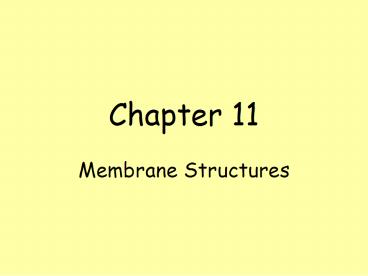Membrane Structures PowerPoint PPT Presentation
1 / 24
Title: Membrane Structures
1
Chapter 11
- Membrane Structures
2
Plasma Membrane
- The container for the cell
- Holds the cytoplasm and organelles together
- Highly selective barrier for the cell
- Bacteria have a single membrane
- Eukaryotes have outer plasma membrane and
internal membranes - Endoplasmic reticulum
- Nuclear membrane
- Membrane-bound organelles
3
Cell Membranes
4
Cell Membrane Functions
- Receives signals from outside the cell for
internal cellular activities - Imports and exports molecules
- Movement of the cell
5
General Structure
- A lipid bilayer that contains 2 sheets of lipids
interdispersed with proteins - Lipid gives the membrane its structure and can
act as permeability barrier
6
Lipid Structure
- Hydrophilic head H2O loving due to polar
group in the head - Hydrophobic tail H2O hating due to the long
hydrocarbon tails
7
Review of Lipids
8
Lipids
- Most abundant lipid is the phospholipid
- Phospholipids have a PO4 group in the 3rd OH
group of the glycerol instead of hydrocarbon - This can attach a hydrophilic group
- Choline phosphyltidylcholine
- Polar amino acids like serine - phosphatidylserine
9
Amphipathic Molecules
- Contain both a hydrophilic and a hydrophobic
portion to the molecule - Form a bilayer because of this
- Other molecules are amphipathic
- Steroids
- Glycolipids lipid with a sugar attached rather
than a phosphate group
10
Other Lipid Molecules
11
Reminder
- Hydrophilic molecules can dissolve in H2O due to
the polarity of both of these molecules - H bonds and other non-covalent interactions may
aid in this
12
Reminder
- Hydrophobic molecules will be caged by the
polar molecules requires energy - Minimize energy requirement if orient the
hydrophobic portions as far away from water as
possible - Why when fats or oils are placed in water that
they usually sit as a glob on the surface
13
Membrane
- Amphipathic molecules have both components so the
hydrophilic head molecules interact with the
aqueous solution and the hydrophobic tails will
interact with each other energetically favorable
14
Lipid Bilayer
- Due to amphipathic property the membrane can
reseal after an injury - Bilayer is fluid the orientation of the lipids
and the outer aqueous surroundings keeps the
lipids in the bilayer - The lipid can move around the layer like one
person moving in a crowded room - Not the same as flexible entire membrane bending
15
Liposomes
- Can study membranes by using artificial membrane
structures called liposomes - Can follow the movement of lipids in each of the
layers
16
What We Know
- Lipids cannot move from one layer to another
without the aid of proteins - Lipids can exchange places with neighbors based
in thermal motion - Decrease the temp will slow down the movement
- Lipids can rotate around their axis - rapidly
17
Importance of Hydrocarbon
- Hydrocarbon tail will determine the fluidity of
the membrane just as it does in fats and oils,
also dependent on temperature - 2 components are important
- Length of hydrocarbon chain
- 14 to 24 C but usually 18 to 20 C per tail
- Short increased fluidity
- Level of unsaturation ( of CC bonds)
- 1 tail has 1 or more CC bonds (unsaturated)
- Other tail is saturated (no CC bonds)
18
Unsaturated Hydrocarbons
- Each CC bond causes a kink or bend in the tail
- Cant pack tightly in the layer
- More lipids that have unsaturated tails the more
fluid the membrane
19
Cholesterol in the Membrane
- Cholesterol is added to areas that have lots of
unsaturated lipids to help fill in the gaps
between the tails - Helps to stiffen and stabilize the bilayer
- Less fluid
- Less permeable
- Only in animal cells
20
Membrane Fluidity
- Enables the membrane proteins to diffuse rapidly
- Simple means of distributing lipids and proteins
- Allows membranes to fuse with one another
- Evenly distributed during daughter cell formation
21
Membranes are Asymmetrical
- Inner surface is different from the outer
surface - Types of lipids in each layer
- Proteins in the bilayer have a specific
orientation due to its function - Both lipids and the proteins in the membrane are
assymetrically distributed
22
New Membrane
- New lipids are added on one side of the membrane
- Enzyme called flippase used to put the lipid in
the other half of the bilayer - Flippase may be selective for the type of lipids
that it puts on either surface
23
Asymmetry
- New membrane comes from the SER
- Vesicle buds off the SER and when fuses with the
plasma membrane, the orientation is maintained - Membranes have distinct inner and outer surface
- Inner cytosolic face
- Adjacent to the cytosol
- Outer non-cytosolic face
- Adjacent to the cell exterior or the interior of
an organelle
24
Special Lipids
- Glycolipids are found only on the non-cytosolic
surface - Sugar added in the Golgi apparatus
- No flippase to move the glycolipid to the
cytosolic surface - Inositol phospholipids are only on the cytosolic
surface - Functions to relay signals on cytosolic surface
that pass through the membrane

